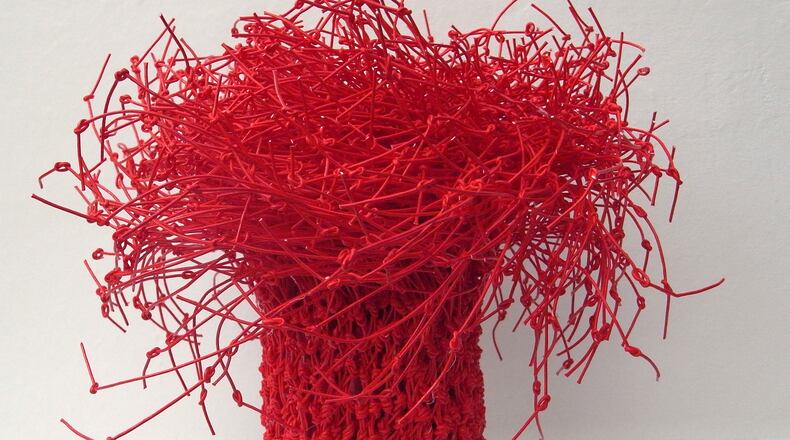In June, when introducing two special exhibitions to the crowd gathered for an opening reception, Dayton Art Institute Asian Art Curator Peter Doebler asked the audience to bring to mind a McDonald’s McDLT sandwich from the 1980s.
“It was served in a polystyrene, double-clam shell container, touting to keep the quarter-pound beef patty hot on one side, and the lettuce and tomato on the other side cool until you combined them in a perfect melding of temperatures,” Doebler said. Then he suggested those who visit the DAI’s current Japanese exhibits might have a similar experience.
That’s because one of the new exhibits is light and airy with a focus on Japanese handmade paper. The complementary exhibit features hard ceramics. Put them together and you have a wonderful blend of striking contemporary art that references traditions of the past. The DAI is the only Ohio venue for “Washi Transformed: New Expressions in Japanese Paper” and “Born of Fire: Contemporary Japanese Women Ceramic Artists.”
Doebler thinks it’s ideal when museums host a wide variety of exhibitions. “Some make you aware of problems but an exhibit can also make you aware of human creativity,” he says. “These Japanese works are beautiful and surprise you with the potential of human creativity. People find this work enchanting.”
Doebler notes that all of us tend to take paper and clay for granted because they are so much a part of our everyday lives. After all, we drink coffee from a ceramic mug and shuffle paper at our desks. But these artists encourage us to look at paper and clay in entirely new ways. “The artists in these exhibitions reawaken us to their magic,” Doebler says. “Ranging from eye-catching artworks that immediately grab your attention to more subtle ones that reward patient looking, they all inspire wonder at both the imagination of the makers and the seemingly infinite variety of what is possible with these humble materials.”
About the clay
The clay artwork in the exhibit comes from the largest collection of contemporary Japanese ceramics outside Japan, the private collection of Carol and Jeffrey Horvitz. Keep in mind ceramics in Japan was a craft traditionally reserved for men. Recently women have received more opportunities and, according to Doebler, are at the vanguard of the medium today.
There are beautiful bowls, shell-like forms and vessels inspired by geology.
You’ll find it hard to believe the sculptural piece of art that looks like a giant cube wrapped in bright yellow fabric isn’t fabric at all but made of clay! It’s titled “D Tsutsumimono (Wrapped Thing)” by Japanese-born Yu Tanaka.
Credit: Ben Bocko
Credit: Ben Bocko
What is washi?
Washi is Japanese handmade paper, traditionally made out of fibers from three plants. Be sure and check out the case in the exhibit that explains washi and shows samples of the paper and the plant fibers before they have been processed.
The 33 works on display are created by nine contemporary Japanese artists; seven of them are female. Their ages range from an artist who was born in the 1930s to one born in 1989. The art ranges from small, two-dimensional paper cuttings to immersive spaces and demonstrates an incredible variety of techniques — twisting, folding, layering, painting, printing and more.
You can literally walk through paper when you enter the dramatic circle of indigo-dyed washi in “Blessed Rain,” a large installation in the exhibit’s final gallery created by Ayomi Yoshida. Look closely and you’ll see printed and painted elements on the paper. Though rain was traditionally seen as a wonderful thing in Japan, in recent years due to climate change and flooding it has often been more of a threat. “The idea is to spotlight environmental issues,” says Doebler, “and it’s a prayer for hope that rain can be seen once again as beneficial.”
One of Doebler’s personal favorites is “Ive,” a pair of folding screens that create a panorama. “It’s beautiful and abstract and it draws you in,” he notes. “It gives you the feeling of looking at an ocean scene and references the long tradition in Japan of using washi for folding screens or sliding doors.”
Meet Yuko Kimura
Yuko Kimura, a Japanese printmaker now living in Cleveland, came to Dayton recently to talk about the artwork she creates blending old and new. She studied printmaking at the Cleveland Institute of Art and the University of Michigan. Kimura works in a Cleveland gallery that specializes in Japanese art and often serves as a translator for those who ship art or come to buy.
In her spare time, Kimura heads for a local non-profit printmaking studio or the renowned Morgan Conservatory, the largest arts center in the United States dedicated to every facet of papermaking, book arts and letterpress printing. “I can make paper there,” she explains. “They make and harvest their own Mulberry there to make washi.”
Kimura loves and uses materials that most people would think of as waste and of no use. “I like aged, decaying kinds of beauty, materials that have history and memory,” she says. “I find them beautiful, including washi where worms have eaten through the pages. I look for old pages whenever I go to Japan. I recycle them to make new work and I sometimes combine it with my homemade paper.”
Her artwork, she explains, combines old and new, East and West. “I use textile techniques like sewing and shibori. (Shibori, a Japanese manual resist dyeing technique, produces patterns on fabric). ”One piece in the show is called ‘Shiwa-shiwa,’ which means ‘wrinkle wrinkle’ in Japanese because I made pleats in the paper.”
Says Kimura: “I love the process so much. My work is not easy for me but if it’s too easy it’s not so challenging. It’s good to be challenged.”
Focus exhibit features Japanese woodblock prints
In 1929, the Dayton Art Institute was given a bound album of Japanese woodblock prints created by Utagawa Hiroshige II, who lived from 1826–1869.
Thanks to recent conservation, these scenes of famous places can now be seen individually in a DAI Focus exhibit that will rotate after three months. This is the first time the prints have been exhibited together in the DAI’s history. Doebler says they provide a window on life in Japan as it was entertaining the modern era.
This exhibition presents prints from Hiroshige’s “Views of Famous Places in Edo.”
Hiroshige II was one of the few students who studied with the artist Hiroshige, who lived from 1797–1858. (He initially used the artist name Shigenobu, but after Hiroshige’s death he married Hiroshige’s daughter and inherited his teacher’s name). His style closely follows that of Hiroshige, with design motifs often echoing the master’s work, but he also added his own innovations.
HOW TO GO
What: “Washi Transformed: New Expressions in Japanese Paper” and “Born of Fire: Contemporary Japanese Women Ceramic Artists.”
Where: Dayton Art Institute, 456 Belmonte Park N., Dayton
When: Through Sept. 17
Admission: General admission: $15 adults; $10 seniors (60+), active military and groups (10 or more); $5 students (18+ w/ID) and youth (ages 7–17); and free for children (ages 6 & younger). Admission is free for museum members.
“Washi Transformed” was organized by Meher McArthur and is toured by International Arts & Artists, Washington, D.C. “Born of Fire” was organized by the Crow Museum of Asian Art of The University of Texas at Dallas.
Related programming:
- Gallery Experiences: 1:30–2:30 p.m. Sept. 2 and 5:30–7 p.m. Sept. 14
- Community Studio Workshop: 5:30–7 p.m. Sept. 7. Cost: $20 for members and $25 for non-members.
- For more information about “Washi Transformed: New Expressions in Japanese Paper” and its related programs, go to daytonartinstitute.org/exhibits/washi-transformed.
- For more information about “Born of Fire: Contemporary Japanese Women Ceramic Artists” and its related programs, go to daytonartinstitute.org/exhibits/born-of-fire-2.
About the Author







